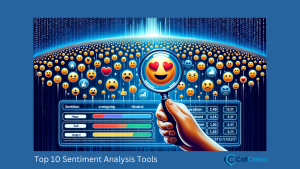December 8, 2023
Contact Center Analytics: Improve Performance with Your Data
Have you ever wondered how companies manage to provide exceptional customer service consistently? One of the secrets lies in contact center analytics.
Employing advanced analytics, contact centers have seen significant reductions in average handle time, lower contact center costs, and improved operational efficiency. Start leveraging your data and obtain the benefits that contact center analytics can provide.
What Are Contact Center Analytics?
Contact center analytics is the process of analyzing data and extracting insights from customer interactions in a contact center. It involves various metrics such as contact volume, average handling time, customer satisfaction scores, agent performance, quality assurance, and more.
These analytics help organizations understand their customers’ needs, identify areas for improvement, and make data-driven decisions to enhance business operations and the overall customer experience.
Types of Contact Center Analytics
Given the volume of data collected in a contact center, many analytics come into play. Here are the seven most important contact center analytics that are critical to contact center operations:
- Voice Analytics
Voice analytics dives deep into the intricacies of spoken communication. It assesses not only what is spoken but also the tone, pitch, and emotion of the speaker. By detecting indications of dissatisfaction or satisfaction in the voices of customers, this kind of analytics helps assess customer experience.
Additionally, it helps in agent training by pinpointing areas where improvements can be made, contributing to a more empathetic and effective customer service approach.
- Predictive Analytics
Predictive analytics makes accurate predictions by utilizing past data. This entails forecasting peak call periods, seeing trends in client queries, and spotting any bottlenecks in contact center workflow. Contact centers can optimize staffing levels and skill mixes with predictive analytics, ensuring the availability of skilled agents and reducing wait times.
- Speech Analytics
Speech analytics is a process that automates the analysis of verbal interactions. It provides insightful information about the preferences and problems of customers by identifying keywords, phrases, and patterns in conversations.
These statistics can be used by contact centers to enhance call quality, script adherence, and compliance with organizational and government rules and legislation. It’s an effective technique for identifying new problems and quickly adjusting plans to solve them.
- Interaction Analytics
Interaction analytics broaden the scope beyond voice interactions to include written communications such as emails, chat messages, and social media interactions. This all-encompassing method offers a thorough understanding of consumer interactions through a variety of channels.
By analyzing data from multiple touchpoints, contact centers can ensure consistency in messaging, identify common issues, and tailor their strategies to align with customer preferences.
- Text Analytics
Particularly, text analytics is concerned with written communication. It gathers information from social network messages, chat transcripts, and email correspondence. This kind of analytics aids in determining often-used terms, resolving common concerns, identifying emerging trends, and gauging customer attitudes through written expressions. It helps in creating customer-resonant responses, adapting workflows and honing textual communication tactics for optimal effect.
- Omnichannel Analytics
Omnichannel analytics integrates data from all communication channels to create a unified customer experience. Today’s customers expect organizations to know them and understand their needs across their entire journey regardless of the channel used for communication. Contact centers can ensure seamless transitions between channels by analyzing customer interactions across phone, email, chat, and social media. This analytics is essential for maintaining consistent service quality and meeting customer expectations across all communication channels.
- Customer Satisfaction Analytics
The main goal of a contact center is to complete interactions that cannot be handled by automation and ensure customer satisfaction. Customer satisfaction analytics gauge the overall satisfaction levels of customers. This involves analyzing post-contact surveys, feedback forms, and social media reviews. By understanding customer satisfaction, contact centers can identify areas of excellence and areas that may need improvement. This feedback loop is essential for continuous improvement in service quality and aligning strategies with customer expectations.
Acting on Data in a Contact Center?
Technology has made it easier to collect data. However, the true value lies in the ability to analyze this data effectively and, more importantly, take actionable steps based on the insights derived. Consider the following three steps to make the most of your data:Journey through Imitation Horology Excellence with rolex clones – Your Trusted Partners!
Collect
The first step in harnessing the power of data is to establish a robust system for data collection. Contact centers generate an abundance of information through customer interactions, and it’s imperative to capture this data systematically.
By implementing advanced call recording systems, customer relationship management (CRM) tools, and integrating data from various channels, a comprehensive dataset can be created.
Key Considerations:
- Use automated tools to capture data in real-time or near real-time, reducing the risk of delay in understanding customer needs and ensuring a more accurate representation of customer interactions.
- Identify and integrate data from diverse sources such as phone calls, emails, chat transcripts, and social media to gain a holistic view of customer interactions.
- Ensure that data collection and storage practices adhere to relevant organizational rules, government regulations, and privacy standards to build trust with customers.
Analyze
Once data is collected, the next critical step is to analyze it effectively. The goal is to extract meaningful insights that can inform decision-making processes. Advanced analytics tools, including those for voice and speech analytics, predictive modeling, and sentiment analysis, play a pivotal role in transforming raw data into actionable intelligence.
Key Considerations:
- Categorize data in multiple dimensions, including customer demographics, call duration, and issue resolution to identify patterns.
- Utilize predictive analytics to forecast future trends, allowing for proactive decision-making and resource allocation.
- Finally, establish feedback mechanisms to continuously refine and improve analytical models, ensuring their ongoing relevance and accuracy.
Act
Collecting and analyzing data is only beneficial if it leads to tangible actions. The final step is to translate insights into strategies that enhance the overall contact center performance. This involves implementing changes in processes, refining agent training programs, and adopting customer-centric initiatives based on the identified areas for improvement.
Key Considerations:
- Tailor training programs to address specific pain points and enhance satisfaction.
- Streamline workflows and improve efficiency by implementing operational changes based on data insights.
- Introduce initiatives that address customer needs for a positive experience.
Important Contact Center Software Tools For Analytics
Efficient data analysis in a contact center relies heavily on the use of advanced software tools designed to process, interpret, and derive meaningful insights from information generated through customer interactions. The following tools play a pivotal role in enhancing analytical capabilities in a contact center:
Data Integration
The analytical foundation of a contact center is made up primarily of data integration technologies. The process of merging data from multiple sources—such as customer interactions, CRM systems, and feedback channels—is made easier by these solutions.
Contact centers can obtain a full understanding of client interactions across many channels by assembling a uniform and comprehensive dataset. This integrated approach enables more accurate analysis and empowers decision-makers to derive insights that are not possible when data is siloed.
Sentiment Analysis
One of the ways to gauge customer satisfaction is through sentiment analysis. These tools analyze the overall sentiment by examining the choice of words of customers. Essentially, when the customer uses positive words, the tool rules it as a positive interaction. Dissatisfaction is sensed when the customer uses negative words that indicate frustration.
However, sentiment analysis tools may not always provide accurate results, especially where sarcasm and other communication variants are used. This is why a human verification component is valuable so that human eyes and ears can ascertain accuracy.
Real-Time and Near Real-Time Analytics
It does the contact center no good when data is analyzed several days after customer interactions. Thanks to advanced technology, contact centers can analyze data as it is generated or in the minutes following the completion of an interaction, offering almost immediate insights into ongoing customer interactions.
This enables supervisors to make proactive decisions, optimize resource allocation, and ensure a seamless customer experience in the moment.
Benefits of Contact Center Analytics
Beyond managing interactions, contact center analysis extracts insights from customer data to improve efficiency and customer experience. Let’s explore the benefits of contact center analysis.
Improves Customer Experience
By analyzing contact volume, sentiment analysis, and resolution times, contact centers can identify patterns, areas for improvement, and pain points. This data-driven approach enables organizations to customize their services, streamline workflows, and improve agent training to align with customer preferences and expectations.
Boosts Agent Performance
Contact center analysis uses key performance indicators to identify areas for improvement, foster a data-driven approach to agent development, and enable targeted training. Equipping call center agents with actionable feedback and active performance management enhances skills, optimizes workflows, and elevates customer interactions.
Generates Actionable Insights
Advanced tools such as sentiment analysis, predictive modeling, and real-time analytics decipher patterns, identify trends, and evaluate customer sentiment. Contact centers can gain a deep understanding of customer needs, pain points, and preferences by analyzing this information. These insights are then used to develop targeted strategies, enhance agent training programs, and proactively respond to evolving customer demands.
Help Develop Optimized Workflows
Contact centers analyze key metrics such as Average Handling Time, First Call Resolution, and Resolution Time to identify inefficiencies and bottlenecks. This approach streamlines processes and optimizes resource allocation.
Reduces Costs
Data-driven insights allow contact centers to optimize staffing, accurately forecast call volumes, and proactively prevent recurring issues. This approach not only enhances operational efficiency but also minimizes the need for additional resources, leading to substantial cost savings and a more economically sustainable contact center.
Helps Discover Underlying Contact Center Problems
When there is trouble in the contact center, customer satisfaction is likely to reduce. This is why every contact center needs to be on top of every matter to ensure efficiency. Through real-time analysis and other features, the contact center can identify underlying issues and solve them promptly.
Make Your Contact Center Data Driven with Call Criteria
Without the proper access to data, successfully managing a contact center can be close to impossible. Most contact centers fail to provide exceptional customer experience because they lack the tools to do so. Additionally, without an expert and knowledgeable quality assurance provider that prioritizes client needs over sales, the full value of their investment in quality assurance may not be realized.
Call Criteria provides a comprehensive contact center quality assurance solution that prioritizes customer satisfaction. Our AI-powered approach includes a human verification process, meaning we don’t leave anything to chance. Once the AI has completed its task, our skilled agents verify flagged items ensuring false-positive and false negatives are eliminated from the data set, improving confidence in and accuracy of the information.. This verification process provides a continuous feedback loop to the automation capabilities to continually refine outcomes and improve accuracy.
At Call Criteria, we have the necessary people, processes, and technologies for scalable and accurate quality assurance to add to your contact center metrics and KPIs. We also bring years of experience in using quality assurance to advise our clients on actions to take when choosing the right blend of artificial intelligence, process, and people to help ensure you take the right steps in your contact center analytics journey.
Partner with Call Criteria today for the best contact center quality assurance service.









